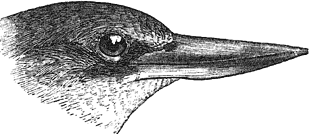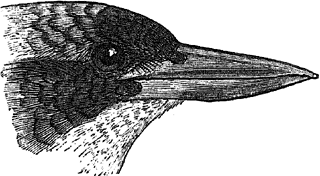|
Page 42 | prev page next page | |||||
|
Genus SAUROPATIS, Cab., 1860 Bill shorter and broader than in Halcyon, and black not red, above at all events; lower mandible much more curved upwards. Plumage marked by a prevalence of bluish green or greenish blue. Sexes alike. This group is chiefly found in the Malay archipelago, Australia, and Polynesia, but two species coins within our limits.
Key to the Species
Fig. 38 - head of S chloris Coloration: Crown, nape, and sides of head to below the eye bluish green. A white streak above the lores occasionally extending back above the eye. Ear-coverts black in some varieties, and with a black band round the nape, separated from the green of the crown by an ill-defined white space (these black and white bands are often entirely wanting). A broad white collar; upper back and scapulars dull bluish green to greenish blue. Lower back, rump, and upper tail-coverts bright blue. Upper surface of wings and tail deeper blue, sometimes with a greenish tinge. Quills, except on outer webs outside, black; lower surface of tail the same. Lower parts white, sometimes tinged with buff, especially on the flanks. Upper mandible, tip and edge of lower mandible greenish black; rest of lower mandible pinkish white; irides deep brown; legs plumbeous (Davison). Size: Length 9.5; tail 2.75; wing 4; tarsus 0.6; bill from gape 2.3 Distribution: Though represented by a variety (H. abyssinica) in the Bed Sea, this Kingfisher has only been obtained in the Indian peninsula near Ratnagiri; it is, however, common in the Sunderbans and throughout the eastern coast of the Bay of Bengal, more abundantly to the southward, in the Andaman islands (it appears to be replaced in the Nicobars by H. occipitalis), and throughout the Malay archipelago to the Philippines and Celebes. In the British Museum catalogue Dr. Sharpe has divided this type into several species and subspecies, all the Indian forms of which appear to me to be races varying considerably amongst themselves and passing into each other. These races are:
H. chloris typical, from the Malay archipelago, a greenish
bird with black ear-coverts and a well-marked black nuchal band. Habits: An inhabitant of sea-shores and of tidal waters, living chiefly on crustacea, but partly on insects, centipedes, small lizards, etc. Hume mentions observing birds of this species hammering shells that contained hermit-crabs against stones in order to break the shells. They are noisy birds. The nest is said to be sometimes made under a stone or bush, but Davison found one in a deserted ants’ nest tenanted by hornets (from the description much like a termites’ nest, a pile of hard clay against a tree trunk) at Mergui. The eggs are said to measure about 1.4 by 1.
Coloration: Similar to that of S. chloris, but the crown is surrounded by a buff rim formed by the lores, supercilia, and a band round the nape; outside this again is a black band, more or less washed with green, especially behind the eyes, and commencing from the eye, including eyes and ear-coverts, and passing round the nape. The lower parts are buff, especially the flanks, wing- lining, abdomen, and lower tail-coverts. As in S. chloris, some specimens are greener than others. In young birds the feathers of the white collar and breast have dark edges. Upper mandible, and the tip and edge of the lower dark horny, rest of lower mandible pinkish; legs and feet pinkish (Hume). Size: Length about 10; tail 2.8; wing 4.25; tarsus 0.6; bill from gape 1.7 Distribution: The Nicobar islands, where this is a common bird. Its nearest ally, H. juliae, inhabits the New Hebrides.
Habits: Very similar to those of H. chloris, but this bird is said by
Davison to be more often found in forest. It lives chiefly on lizards and
shell-fish. Davison found three nests on Camorta, all in ants’ nests of clay,
12 to 30 inches in diameter and 4 to 20 feet from the ground, against trunks
of trees. There was a tunnel 6 inches long and 2 or 21/2 in diameter, leading to
the bird’s nest, a chamber 7 inches across. A single egg, obtained from a
female that was shot, measured 1.16 by 0.98. Genus CARIDAGRUS Cab., 1860. Sexes differing in plumage, and one or both spotted. Bill broader and tail shorter than in Sauropatis. Two or three species are found in the Philippines, and one, a Malay form, ranges into southern Tenasserim.
Coloration: Male. Crown and nape deep green, paler, brighter, and sometimes bluer on the nuchal border. The lores and a band from them, including the eye, passing above the ear-coverts and round the nape black, forming a border to the green crown. A ferruginous supercilium extending to the lores in front and to above the ear-coverts behind; another ferruginous band from the gape including the ear-coverts and extending to the broad collar round the hindneck, which is of the same colour but deeper in tint. A broad blue cheek-stripe below the ferruginous band; a narrow black collar behind the ferruginous collar. Interscapular region, scapulars, and upper surface of wings and tail deep blue. Wing-coverts and scapulars with brighter edges; middle of lower back, of rump, and generally of upper tail-coverts bright pale cobalt-blue. Sides of lower back and rump black; quills black, except basal parts of outer webs above, which are blue, and the inner borders, which are buff. Lower surface of tail-feathers also black; lower parts ferruginous, whitish or white in middle of abdomen and on lower tail-coverts. Female. Back and wings above dull green, with pale buff spots on the scapulars and wing-coverts. Young males have similar pale spots, although except in being duller the plumage resembles that of adults of the same sex. Nestlings of both sexes resemble adults of the same sex. Bill above black, lower mandible and edges of upper chrome-yellow; irides deep brown; legs chrome-yellow (Davison). Size: Length about 9.6; tail 2.5; wing 4.5; tarsus 0.75; bill from gape 2.4 Distribution: Malay peninsula with the extreme south of Tenasserim, Sumatra and Borneo. Habits: According to Davison this Kingfisher is not found near water, but in thick forest, and lives on lizards and large wood-lice.
A small genus of only two species, one confined to Borneo, while the other is found in Burma etc. Sexes very different in colour, the males barred with blue and black above, the females with rufous and black. Feathers of nape slightly elongate. Bill broad, comparatively short; culmen straight, rounded. First primary shorter than all the other primaries; tail moderately long, rounded at the end. This approaches Dacelo, the “laughing jackass” of Australia, in structure, more than any other Indian or Burmese Kingfisher does.
Fig. 39 - head of C. pulchellus Coloration: Male. Broad frontal band, sides of head and neck, and a more or less perfect collar round the hindneck chestnut. Occiput and nape cobalt-blue, base of the feathers white, banded with black near the blue tip. Remainder of upper plumage, including the wings and tail, banded black and verditer-blue, the feathers barred with white instead of blue except at the ends or exposed portions. Quills black with white inner margins, the secondaries with white spots forming imperfect bars. Lower parts white; breast, flanks, and under wing-coverts tinged with dull rufous. Tail-feathers barred with white beneath. Female. Upper parts and sides of head and neck transversely banded with black and pale brownish rufous, more narrowly on the head and neck; primaries brown, unbanded. Lower parts white, with black spots forming imperfect bars on the breast and flanks. Bill vermilion; irides purplish grey; legs and feet dull pale green (Davison). Size: Length about 8.5; tail 2.75; wing 3.5; tarsus 0.5; bill from gape 1.8 Distribution: Pegu (not Arakan) and Tenasserim, more common in the latter; the Malay peninsula, Sumatra and Java.
Habits: Generally found away from water in forest, feeding on small
lizards and various insects. Nidification unknown. |
| |||||
| prev page :: next page | ||||||
 birding.in | |
| Genera Sauropatis, Caridagrus & Carcineutes - Kingfishers
|
| |||||||||||||||||||||

